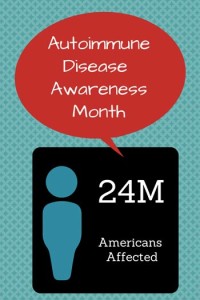Have Celiac? You Should Know About Autoimmune Disease Awareness Month
March 3, 2014 by Amy Leger | G+ Amy Leger Celiac disease is an autoimmune disorder that affects 1 in 133 Americans. Most are undiagnosed. But celiac disease is only one autoimmune disorder of more than 80 causing major health issues for people across the country.
Celiac disease is an autoimmune disorder that affects 1 in 133 Americans. Most are undiagnosed. But celiac disease is only one autoimmune disorder of more than 80 causing major health issues for people across the country.
This article is Part 1 of 3 in a series: the other parts are Women and Autoimmune Disease and Preventing Autoimmune Disease.
An autoimmune disease, is basically when the body attacks itself. The National Institute of Arthritis and Musculoskeletal and Skin Diseases (NIAMS) describes it this way: “In an autoimmune reaction, antibodies and immune cells target the body’s own healthy tissues by mistake, signaling the body to attack them.”
The National Institutes for Health estimates nearly 24 million people have an autoimmune disease. The American Autoimmune Related Diseases Association (AARDA), believes that number is much higher, “We at AARDA say that 50 million Americans suffer from autoimmune disease. Why the difference? The NIH numbers only include 24 diseases for which good epidemiology studies were available.”
Much is still unknown about what causes or triggers an autoimmune disease. There does seem to be a genetic component where clusters of autoimmune diseases happen within families. On my side of the family, for example, my dad and brother have celiac and my mom has rheumatoid arthritis. I have nothing so far….but I keep looking over my shoulder awaiting for something to rear its ugly head.
AARDA reports massive health care costs with autoimmune disorder treatments. “NIH estimates annual direct health care costs for AD to be in the range of $100 billion (source: NIH presentation by Dr. Fauci, NIAID),” AARDA.org says. “In comparison, cancers costs are $57 billion (source: NIH,ACS), and heart and stroke costs are $200 billion (source: NIH, AHA).”
Autoimmune Diseases:
Here is at least a partial list of the autoimmune diseases from the NIAMS. I found the definitions and links to a primary resource for each of them:
Alopecia Areata According to the National Alopecia Areata Foundation, “Alopecia areata is a common autoimmune skin disease resulting in the loss of hair on the scalp and elsewhere on the body.”
Autoimmune Hemolytic Anemia The NYU Langone Medical Center says “Autoimmune hemolytic anemia is caused by the destruction of healthy red blood cells (RBCs). It can be a serious, fatal condition that requires care from a doctor.” Anemia in general is a “low level of healthy red blood cells (RBC). RBCs carry oxygen from the lungs to the rest of the body. When red blood cells are low the body does not get enough oxygen. This can cause symptoms such as fatigue, pale skin, or irregular heartbeat.”
Autoimmune Hepatitis The National Digestive Diseases Informational Clearinghouse reports “Autoimmune hepatitis is a disease in which the body’s immune system attacks liver cells. This immune response causes inflammation of the liver, also called hepatitis.”
Celiac Disease (aka Celiac Sprue) The National Digestive Diseases Informational Clearinghouse explains on its website that “celiac disease is a digestive disease that damages the small intestine and interferes with absorption of nutrients from food. People who have celiac disease cannot tolerate gluten, a protein in wheat, rye, and barley.” If you have questions about living with celiac, raising a child with celiac or doing the gluten free diet, you have come to the right website with thesavvyceliac.com.
Dermatomyositis According to the Mayo Clinic, uncommon inflammatory disease marked by muscle weakness and a distinctive skin rash.
Diabetes (type 1) The Juvenile Diabetes Research Foundation (JDRF) says Type 1 Diabetes “is an autoimmune disease in which a person’s pancreas stops producing insulin, a hormone that enables people to get energy from food. It occurs when the body’s immune system attacks and destroys the insulin-producing cells in the pancreas, called beta cells.”
Glomerulonephritis The National Library of Medicine explains Glomerulonephritis is a type of kidney disease in which the part of your kidneys that helps filter waste and fluids from the blood is damaged
Graves’ disease The Mayo Clinic defines Graves’ Disease as an immune system disorder that results in the overproduction of thyroid hormones (hyperthyroidism). While a number of disorders may result in hyperthyroidism, Graves’ disease is the most common cause.
Idiopathic Thrombocytopenic Purpura (ITP) According to the National Library of Medicine, Idiopathic thrombocytopenic purpura is a bleeding disorder in which the immune system destroys platelets, which are necessary for normal blood clotting. Persons with the disease have too few platelets in the blood.
Myasthenia Gravis (MG) The Myasthenia Gravis Foundation of America, Inc. says “the most common form of MG is a chronic autoimmune neuromuscular disorder that is characterized by fluctuating weakness of the voluntary muscle groups.
Multiple Sclerosis (MS) The National Multiple Sclerosis Society defines MS involving “an immune-mediated process in which an abnormal response of the body’s immune system is directed against the central nervous system (CNS), which is made up of the brain, spinal cord and optic nerves. The exact antigen — or target that the immune cells are sensitized to attack — remains unknown, which is why MS is considered by many experts to be ‘immune-mediated’ rather than ‘autoimmune.'”
Pemphigus or Pemphigoid The International Pemphigus & Pemphigoid Foundation says “Pemphigoid is a group of subepidermal, blistering autoimmune diseases that primarily affect the skin, especially the lower abdomen, groin, and flexor surfaces of the extremities. Here, autoantibodies (anti-BPA-2 and anti-BPA-1) are directed against the basal layer of the epidermis and mucosa.”
Pernicious Anemia According to the National Heart, Lung and Blood Institute, “Pernicious anemia is a condition in which the body can’t make enough healthy red blood cells because it doesn’t have enough vitamin B12….The body needs this nutrient to make healthy red blood cells and to keep its nervous system working properly. People who have pernicious anemia can’t absorb enough vitamin B12 from food. This is because they lack intrinsic (in-TRIN-sik) factor, a protein made in the stomach. A lack of this protein leads to vitamin B12 deficiency.”
Polyarteritis Nodosa The Cleveland Clinic reports “Polyarteritis nodosa (PAN) is a rare disease that results from blood vessel inflammation (“vasculitis”) causing injury to organ systems. The areas most commonly affected by PAN include the nerves, intestinal tract, heart, and joints. PAN can also affect the blood vessels to the kidney resulting in high blood pressure and damage to kidney function.”
Polymyositis This autoimmune disease involves the muscles, says the Mayo Clinic. “Polymyositis is a persistent inflammatory muscle disease that causes weakness of the skeletal muscles, which control movement. Medically, polymyositis is classified as a chronic inflammatory myopathy — one of only three such diseases.”
Primary Biliary Cirrhosis The American Liver Foundation reports “Primary biliary cirrhosis, or PBC, is a chronic, or long-term, disease of the liver that slowly destroys the medium-sized bile ducts within the liver. Bile is a digestive liquid that is made in the liver. It travels through the bile ducts to the small intestine, where it helps digest fats and fatty vitamins.”
Psoriasis The National Psoriasis Foundation explains that “Psoriasis is an autoimmune disease that causes raised, red, scaly patches to appear on the skin…Psoriasis can occur on any part of the body and is associated with other serious health conditions, such as diabetes, heart disease and depression.”
Rheumatoid Arthritis According to the Arthritis Foundation, “Rheumatoid arthritis (RA) is an autoimmune disease in which your body’s immune system – which protects your health by attacking foreign substances like bacteria and viruses – mistakenly attacks your joints. The abnormal immune response causes inflammation that can damage joints and organs, such as the heart. Early diagnosis and prompt treatment is the key to preventing joint destruction and organ damage.”
Scleroderma The Scleroderma Foundation says “Scleroderma, or systemic sclerosis, is a chronic connective tissue disease generally classified as one of the autoimmune rheumatic diseases. The word ‘scleroderma’ comes from two Greek words: ‘sclero’ meaning hard, and ‘derma’ meaning skin. Hardening of the skin is one of the most visible manifestations of the disease.”
Sjögren’s syndrome “Sjogren’s (SHOW-grins) syndrome is a disorder of your immune system identified by its two most common symptoms — dry eyes and a dry mouth,” explains the Mayo Clinic. “Sjogren’s syndrome often accompanies other immune-system disorders, such as rheumatoid arthritis and lupus. In Sjogren’s syndrome, the mucous membranes and moisture-secreting glands of your eyes and mouth are usually affected first — resulting in decreased production of tears and saliva.”
Systemic Lupus Erythematosus The National Library of Medicine explains “Systemic lupus erythematosus (SLE) is an autoimmune disease in which the body’s immune system mistakenly attacks healthy tissue. It can affect the skin, joints, kidneys, brain, and other organs.”
Vitiligo According to the Mayo Clinic, Vitiligo (vit-ih-LI-go) is a condition in which your skin loses melanin, the pigment that determines the color of your skin, hair and eyes. Vitiligo occurs when the cells that produce melanin die or no longer form melanin, causing slowly enlarging white patches of irregular shapes to appear on your skin.
Again, there are many more that could be on this already lengthy list.
What will you do to learn more or raise awareness about autoimmune disease this month? Watch for a few posts and tweets (@AmyLeger) on the subject throughout March.
Tags: autoimmune, celiac, diabetes, disease, gluten, gluten-free, graves, lupus, rheumatoid arthritis



March 3rd, 2014 at 8:54 am
Hashimoto’s Thyroiditis is autoimmune as well. It is the polar opposite of Graves’ Disease.